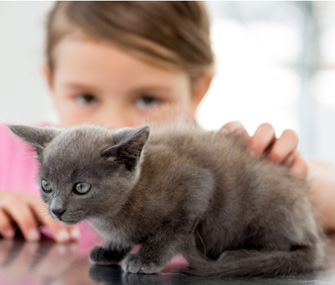What to Consider Before Getting a Cat for Your Kids
by Jenn Andrlik
Published on December 11, 2014
Skip To

Have You Considered the Impact?
Don’t go to a shelter or breeder before preparing yourself and your family. Do your research and consider how owning a cat will change not only your child’s life, but yours as well. Remember, you are bringing a new family member into the mix, and anytime you do this,
whether it be a new baby or a new pet, there will be an adjustment
period. You will need to determine whose responsibility it will be to take
care of the new kitty, and how you’ll divide up the duties among family members.
You may also need to alter your schedule to accommodate the cat’s needs, like feeding him before work or school in the morning and finding time to take him to veterinary appointments.
If you do decide to add a cat to your family, consider having your child open a photo or a note stating that you’re getting a cat before you actually bring one home. In addition, you should have a conversation with your child about how getting a cat will change her life and what she thinks her responsibilities will be, to make sure your expectations match hers. This will give your child time to absorb the surprise and really think about the new "gift."
Do You Have the Time?
A pet will take a lot of time. Not only for your child, but for you as well. Of course, you’ll need to do the obvious duties like feeding the cat and making sure his litterbox is clean, but you’ll also need to work with your child to help ensure she understands the body language of the cat. Your child should learn to recognize when the cat wants attention and when he wants to be left alone. And supervising any interaction your child has with the cat is imperative. You’ll not only need to train the cat, but you’ll also need to work with your child. Teach your child the right way to pet the cat (on his back, shoulder, neck and top of the head, according to Dr. Marty Becker). Most cats will tolerate this type of petting better than on the face, paws, tail or belly.
You’ll also need to teach your child how to hold the cat, says Dr. Becker. With supervision, children ages 4 and older can attempt to pick up the cat. For a child under 4, have her sit down and hand the cat to her. Then she should cradle him firmly but gently in her arms, against her chest and with one arm supporting the cat’s hind legs. And let the cat (rather than the child) dictate how long he is held (and whether he wants to be held at all, period). Read everything you can about children and cat interactions, suggests trainer Mikkel Becker. The more you learn ahead of time, the more you will be able to help foster a good relationship between your cat and your child.
Are You Financially Prepared?
Even if you don’t spend much to buy or adopt a cat, a pet can be costly. Be sure to consider all that you’ll have to pay for before committing and let your child in on the decision. Keep in mind the cost of boarding or pet-sitting when you go out of town, and the cost of veterinary bills, both for regular care and if the cat becomes ill. Can you afford a cat day to day? Can you also afford for something unexpected to happen?
What Kind of Cat Is Right for Your Family?
Although you may think a kitten is the best idea because kittens are cute, cuddly and small like your child, the American Humane Association recommends homes with children get adult cats. “Young children may be too rough with fragile kittens. Similarly, young kittens have particularly sharp teeth and claws, which can accidentally injure delicate young children,” according to the American Human Association website. The group also recommends that parents take an initial trip to the shelter or breeder to look at a variety of cats before involving their children. Once you’ve narrowed your options to a few or have a specific cat in mind, then you can introduce your child to the cat. You may want or need to do this over a few visits, and both you and the child should be gentle and read the cat’s body language. If the cat hisses or backs away, it means the cat is not comfortable and may not be the best fit for your family.
In addition to choosing a kitten or an adult cat, you might want to think about what kind of cat to get. Certain breeds tend to be better with children than others. Don’t miss our list of 12 cat breeds we recommend for families.
Is Now the Right Time to Get a Cat?
It is important to consider the timing of getting a cat. If you still have a growing family or are planning a big change, such as a move, it may not be the best time to introduce a cat. You want to make the addition of a cat to your family as seamless as possible, both for you and your new pet. If you’re pregnant or plan to become pregnant soon, you need to be aware of the health risks due to toxoplasmosis, and, additionally, be mindful of the fact that multiple major changes at once can be emotionally taxing on all members of the family. Getting a new pet is a big change, and can be amazing, but you may want to reconsider bringing home a new cat right now, if you’re planning any other major events in the near future.
More on Vetstreet.com:





